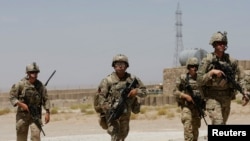The United States is positioning more firepower in the Middle East and South Asia to provide cover for U.S. troops as they prepare to leave Afghanistan.
The Pentagon on Friday announced that Defense Secretary Lloyd Austin had ordered the USS Dwight D. Eisenhower aircraft carrier to remain in the region for "a period of time." Long-range bombers are also headed to the region, and two U.S. Air Force B-52s are already in place.
"We want to make this a safe, orderly and deliberate drawdown," Pentagon press secretary John Kirby told reporters. "That means giving the commander on the ground … options to make sure that our forces and our troops and those of our allies are protected as they move out."
U.S. President Joe Biden announced last week that he was pulling the approximately 2,500 to 3,500 U.S. troops out of Afghanistan beginning May 1, and that the withdrawal would be completed by early September.
U.S. allies, who have another 7,000 or so troops in Afghanistan under the auspices of NATO, are also leaving, along with thousands of contractors, under the same timeline.
Taliban threats
Despite the planned pullout, Taliban officials have repeatedly threatened to target U.S. and coalition forces if they fail to leave Afghanistan by the start of May — the deadline under an agreement signed between the Taliban and the administration of former U.S. President Donald Trump.
"It would be foolhardy and imprudent not to assume that there could be resistance and opposition to the drawdown by the Taliban given their staunch rhetoric," Kirby told reporters about the threats, leaving open the possibility that additional steps could be coming.
"It's entirely possible there will be a temporary increase of some ground forces and enablers, not just for force protection but also for logistical and engineering support."
During a briefing at the Pentagon on Thursday, the commander of U.S. forces in the Middle East and Afghanistan, General Kenneth "Frank" McKenzie Jr., raised concerns about the ability of Afghan forces to hold off the Taliban once U.S. troops leave. But he also warned the insurgent group against going after U.S. or coalition forces in the interim.
"I believe it is probably the Taliban's intent to conduct military operations," McKenzie said, adding that they have "never stopped fighting."
"I would advise the Taliban we will be prepared to defend ourselves," he said.
The U.S. is also finalizing plans to remove equipment and supplies from Afghanistan, much of which will be flown out of the country.
But the Defense Department said not all of it would be coming home.
"Some of it will be inspected, cleaned and deployed elsewhere in the region. Some of it will be provided to our Afghan partners, if it makes sense," the Pentagon's Kirby told reporters. "And some of it will be destroyed."









